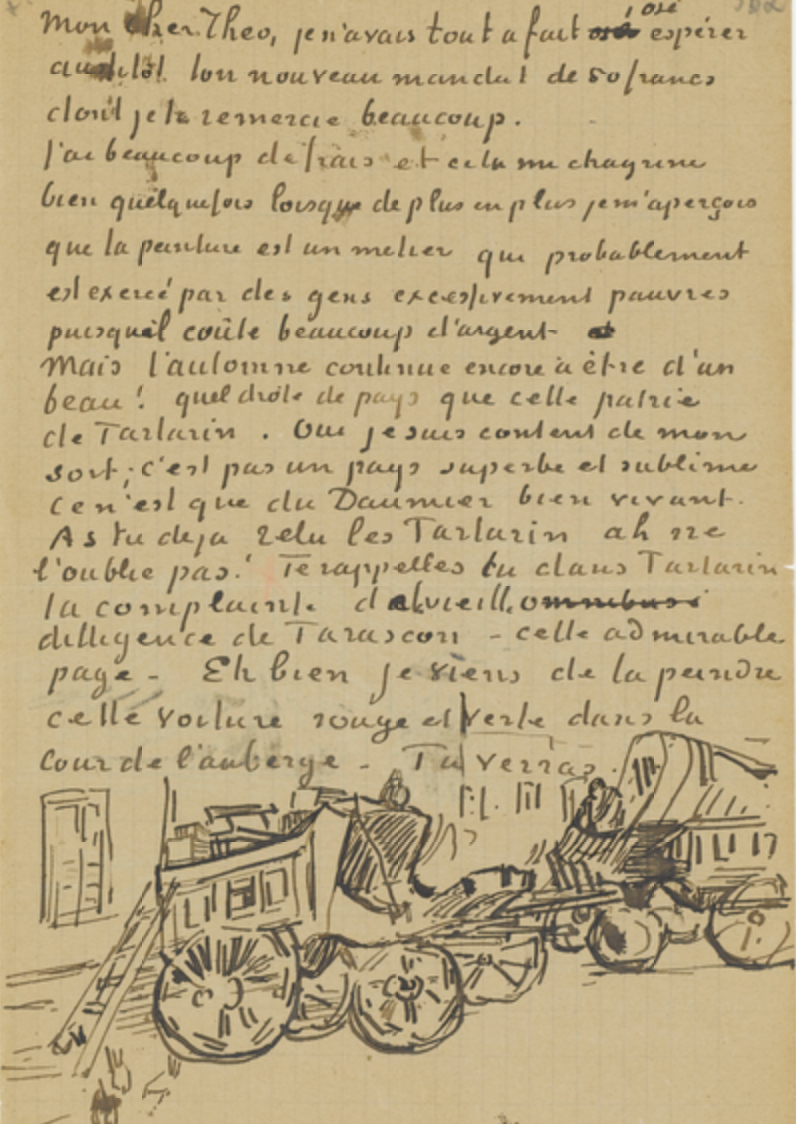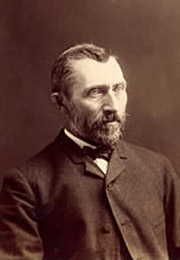


Oil on canvas
71.4 x 92.5 cm. (28 1/8 x 36 7/16 in.)
frame: 99.5 x 119.0 x 10.5 cm. (39 3/16 x 46 7/8 x 4 1/8 in.)
L.1988.62.11
Theo van Gogh (1857–1891); [on consignment to Julien (Père) Tanguy (1825–1894), by 1891]; sold to Medardo Rosso (1858–1928), Paris, by 1895; given to Milo Beretta (1870–1935), Montevideo, 1895; by descent to Beretta’s six heirs, 1935; [sold to Paula (de) Koenigsberg, La Passe Ltd., Buenos Aires, by 8 May 1946]; sold to Henry Pearlman, June 1950; Henry and Rose Pearlman Foundation, after 1974.
“You used to have a very fine Claude Monet showing four colored boats on a beach. Well, here they are carriages, but the composition is the same in style.”
-Vincent van Gogh to his brother, Theo, October 13, 1888

The drama of his mental illness and tragic suicide sometimes overshadows Van Gogh’s sophistication as an artist. As this passage from one of his many letters to his brother suggests, he was a thoughtful craftsman, who, like the Impressionists, painted outdoors and demonstrated a mastery of legible brushstrokes, complex compositional devices, and a brilliant palette. At the same time, however, he transformed their style in his own distinctive way – by applying paint in thick marks, crosshatched strokes, and flowing lines of intense color.
The exceptionally well-preserved paint texture in this work ranges from high peaks of thickly impastoed oils (the yellow wall, gray courtyard, and greens of the carriages) to unpainted canvas (between the spokes of the back wheel). Closed shutters suggest that it is siesta time, and short shadows indicate the early afternoon. The inn portrayed is in Arles, midway on the stagecoach’s route.
Analysis undertaken by the Van Gogh Museum in 2008 identified the roll of canvas that Van Gogh purchased in September, 1888, and which arrived on the 9 or 10 of October. This roll was used to create at least four works, including “Tarascon Diligence,” before “The Bedroom” on 16 October, and then three additional works after. The next roll of canvas, requested on 22 October, would be shared with Paul Gauguin, who arrived the following day..
In 1895 the legendary Paris art dealer Ambroise Vollard included “Tarascon Diligence” in an exhibition of the artist’s work. Although the show was not a commercial success, it was significant as the first major posthumous Van Gogh exhibition.
Many of the early writers on Van Gogh knew that a painting of the Tarascon Coach existed because of a letter from Vincent to his brother, Theo, in which he described the work…
Many of the early writers on Van Gogh knew that a painting of the Tarascon Coach existed because of a letter from Vincent to his brother, Theo, in which he described the work and drew a sketch of it. The sketch was reproduced in early books on Van Gogh with the statement that the original painting was lost. In Vincent’s letters to Theo, he keeps reminding him to please re-read Alphonse Daudet’s Tartarin of Tarascon. Daudet describes the dream of the “Diligence,” or coach, which had been transplanted to northern Africa for use as the main method of transportation; of the traveling Arabs who neglected the coach until it was rundown and unfit for use, and finally broken up for firewood. Vincent paints these coaches in a somewhat dilapidated state.
Vincent relates in his letter to Theo that he painted the Tarascon Diligence in a single afternoon: “Forgive this very bad sketch, I am nearly dead with painting that Tarascon Diligence, and I see that I have not the brains to draw.” He was at a very high emotional state at the time, preparing his house for Gauguin’s arrival to live with him, and anxious to have many of his paintings on the walls showing his own individuality before the latter arrived. I had the pleasure of showing the painting to Vincent Van Gogh, the nephew of the painter, who was seeing this work for the first time although he had known of its existence for many years.

Vincent Van Gogh (1853-1890)
The work of Vincent van Gogh (1853–1890) is inextricably linked to his fabled life, which epitomizes the romantic legend of the artist as a misunderstood and psychologically tormented genius. Although he famously sold only a single work over the course of his short but prolific career, Van Gogh developed a highly individualistic style of painting that was revered by subsequent generations of avant-garde painters, beginning with the Fauves and Expressionists.
Hailing from a Dutch family, his father a clergyman, Van Gogh left school to become an apprentice at an art dealership where a relative worked. From this vantage point, he learned about both Old Master and contemporary paintings while collecting contemporary British illustrations. Fired from his job in 1876, he was spurred by deep religious fervor to work as evangelist among miners in a downtrodden area of Belgium. His failure was apparent after just a few years, and in 1880, on the verge of a breakdown, he visited the artist Jules Breton, who inspired a new ambition of becoming a painter of peasants. Almost entirely self-taught, Van Gogh had only sporadic episodes of formal training.
Supported by his brother Theo, who was an art dealer, Vincent moved to Paris in 1886, and through Theo became acquainted with Impressionist artists. He soon adopted broken brushstrokes and vivid contrasts of complementary colors, particularly influenced by Georges Seurat’s pointillist innovations. Van Gogh was also deeply influenced by the expressive graphic devices of Japanese prints, which were then in fashion. He translated these elements into his own distinctive style, based on thick layers of impasto paint whose undulating rhythms captured a psychic intensity.
In early 1888, Van Gogh moved to the town of Arles in the south of France, drawn to the clarity of light, vivid colors of landscape, and rustic lifestyle. Hoping to create an artists’ community there, he was briefly joined by Paul Gauguin for an intense period of working together before a major falling-out. At the time, Van Gogh experienced a psychological breakdown that infamously resulted in the artist cutting part of his left ear. Committing himself to an asylum in Saint-Rémy for a year, Van Gogh continued work on views of the surrounding countryside as well as portraits, including a number of penetrating self-portraits. He spent his last months closer to Theo in Paris, under the care of Dr. Paul Gachet at Auvers-sur-Oise, where he continued to paint with great fervor. He was just beginning to receive favorable critical attention when he suffered another psychological attack and apparently shot himself in the chest, dying a few days later with Theo at his side. His copious illustrated letters to Theo and others, full of details about his life and art, were published posthumously and have contributed to both his fame and the biographical readings of his work.